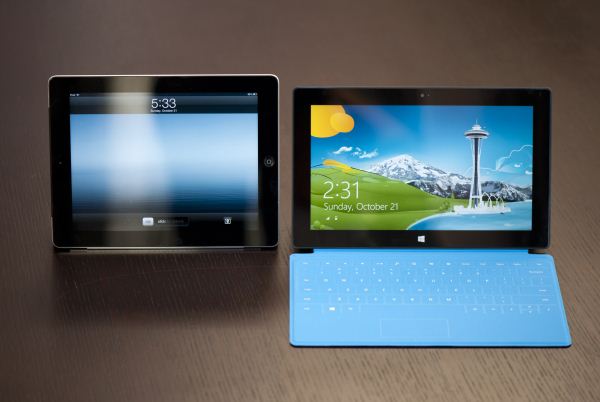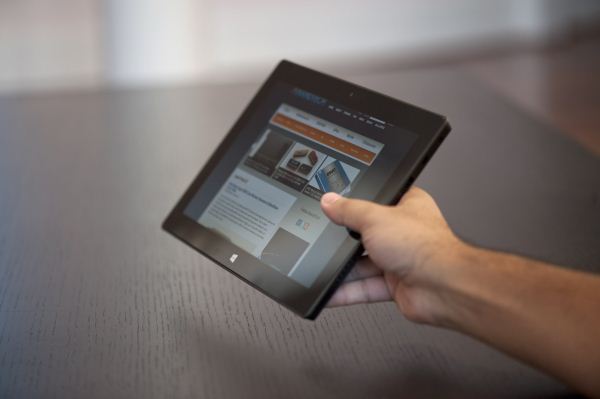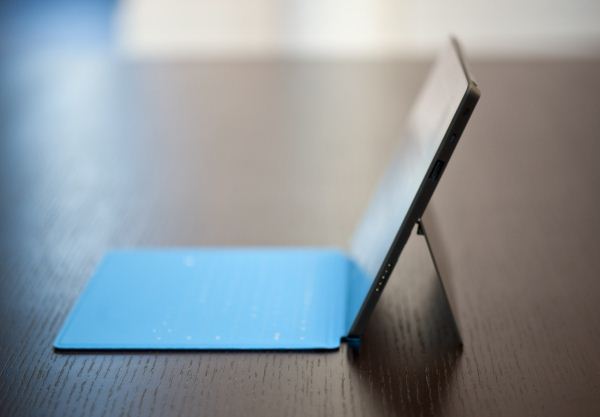Microsoft Surface Review
by Anand Lal Shimpi on October 23, 2012 9:01 PM EST- Posted in
- Tablets
- Microsoft
- Mobile
- Surface
- Windows RT
Surface: Simply Put
Surface is very well built and extremely well designed. It’s easily among the best built products I’ve had the opportunity to handle, and definitely puts a lot of earlier attempts from far more experienced companies to shame. I wouldn’t say that it looks better or worse than the iPad, it’s simply different. I talked about perspectives earlier, Microsoft’s perspective on tablets is a bit more utilitarian than Apple’s and Surface’s design reflects that reality.
Where the iPad is curvy and without any IO expansion, Surface is squared off with 22-degree beveled edges. The iPad features a light aluminum finish while Surface contrasts with its dark Magnesium surface. Not better or worse, just different.
Surface is both larger and heavier than the iPad, both design decisions on Microsoft’s part to built a device that could better deal with Windows RT’s multitasking capabilities as well as make room for a comfortable typing area when used with one of its two keyboard covers.
The added weight is offset by superb internal weight distribution. Microsoft claims a lower moment of inertia by more evenly distributing weight inside Surface’s chassis. I don’t know that I’d consider Surface light but it is very comfortable to carry around. It’s not quite like porting around a pad of paper, but carrying Surface feels very natural.
The focus on weight distribution results in a device that is honestly comfortable to hold in tablet mode and very comfortable to carry around. The more squared design of Surface actually makes in hand feel more like a book than the iPad, which was an early goal for the device.
The chassis is built out of an injection molded Magnesium, which gives it a very different feel to most machined Aluminum or plastic tablets we’ve used in the past. Microsoft calls this process VaporMg (vapor-mag) and I have to say that I’m pleased with the outcome. Surface’s finish is smooth and lacks the same texture that we’ve come to expect from machined Aluminum. The device feels very durable and doesn’t seem to scratch or scuff easily, although I didn’t purposefully try to mar my review unit over the past week. Striking a balance between robustness and light weight is very tricky business when building mobile devices, Surface easily falls on the robust side of the scale without feeling overly heavy. I never felt that the device was too fragile.
The power of Surface is in its flexibility. Microsoft’s talents not as a software developer nor as a parts assembler are what make Surface great here, rather its design and manufacturing intuition. I would’ve expected Surface to come from a company that had much more experience in designing and building tablets and PCs, not from a company that’s traditionally known for putting stickers all over them.
Surface’s flexibility comes from three areas: the tablet itself, the integrated kickstand and the optional Touch/Type covers. In tablet mode, Surface is Microsoft’s take on the new wave of tablets. It delivers the same intimate content consumption experience that you’d get from other tablets but with the added benefits of Windows RT, such as improved multitasking and better task switching.
Surface also features an integrated kickstand, also made out of the same VaporMg process as the rest of the chassis.
Microsoft wants you to be able to quickly transition between notebook, tablet and display modes. It’s rare that I see a goal so well executed. Surface really masters the art of quick transitions between all three modes. I can be in word, typing out this review and quickly switch to a tablet mode where I’m browsing the web with the keyboard cover folded neatly behind the display. If I need to respond to a comment or answer an email, I can just as easily switch back. The kickstand is a necessary part of enabling these quick transitions, and it does its job well.
There’s only one side of Surface that has a cutout for you to easily flick the stand out from its resting place. The kickstand’s range of motion does take some getting used to. It’s spring loaded enough to pop out at good velocity (and strong enough to pinch your skin nicely if you close it on a part of your finger by accident). When deployed it positions the top of Surface away from you at a 22-degree angle, matching the bevel of Surface’s edge.
With a fixed angle of deployment the kickstand doesn’t always deliver the best viewing experience, although it’s usually good enough. The kickstand is perfect for desk use and even for using while reclined on a couch or even in bed. Where it does fall short is if you’re hunched over Surface on an airplane in coach without a lot of room to move the device away from you. In those situations you’re going to find that you’d wish the kickstand could open at a wider angle.
Microsoft is particularly proud of the acoustics and feel of the kickstand. In my experience I felt the kickstand actuated nicely but I don’t know if I’d go so far as to draw the luxury car door comparison. The best way I can put it is the kickstand never feels cheap and doesn’t rattle, it works and gives you the confidence that it’ll always work and not just break after half a year. It’s not often that I find a substantial moving part on a mobile device that I feel is more functional than gimmicky. Surface’s kickstand is definitely a job well done.
The third element of Surface that makes it a very flexible device is also responsible for the splash of color in the design that gives the otherwise business appearance a consumer twist. I’m talking about Surface’s Type and Touch Covers.



















235 Comments
View All Comments
kyuu - Tuesday, October 23, 2012 - link
Agreed, I'd like some clarification on this as well. I certainly hope it's a simple micro-HDMI that can be used with off-the-shelf adapters.ervinshiznit - Tuesday, October 23, 2012 - link
Anand,You mention that you would have liked to have seen the surface with x86. Is Windows RT only compatible with ARM or does it support x86 also? I realize it's just a compilation issue but I was under the impression that only ARM builds of Windows RT would ever be released by Microsoft.
MadMan007 - Tuesday, October 23, 2012 - link
Don't connect the hardware branding name 'Surface' and software. You are correct that WinRT=ARM only. But there will be Microsoft Surface devices using x86 hardware running full Windows 8.Will there be a budget Atom-based x86 Surface, in the same form factor as this one? I'm not sure off the top of my head, but that's probably what Anand meant.
ervinshiznit - Tuesday, October 23, 2012 - link
There have only been plans announced for the Surface Pro, which would include a Core i5 and run full Windows 8.I bring up the Windows RT=ARM only because Anand brought up the performance issue in the context of MS Office, and he said that he would have liked to see an Atom in the Surface instead of this ARM core. But then it wouldn't be able to run RT. And that would also mean no free Office 2013 since it's not included in full Windows 8
Ryan Smith - Tuesday, October 23, 2012 - link
Whether or not to include Office is basically arbitrary. Microsoft could include it with Surface Pro, as it's entirely up to them..The point to take home is not that RT doesn't run on Atom, but rather that Office on Surface is currently unusually sluggish. A SoC with better performance in lightly threaded situations (such as the Atom) would handle Office better based on what we're seeing.
Kevin G - Wednesday, October 24, 2012 - link
Reading through this review and others seems to point the problem at Office being sluggish and not necessarily the Tegra 3. Even on the PC side where far higher performing hardware exists, Office doesn't give the impression of a speed champion. I'd love to see Office compared on the Surface, Surface Pro and a decent laptop. Yeah, the deck would stacked in favor of the laptop winning but it'd be a good reference point for users as well as reviewing the idea of usability on each device. For example, I can see the utility of viewing and making a quick and simple change to an Excel spread sheet on a tablet but for heavy Excel use restricted to an on screen touch keyboard would likely result in levels of frustration that'd have me snapping the tablet in two.kyuu - Thursday, October 25, 2012 - link
That's the reason for the Touch/Type Covers...ervinshiznit - Tuesday, October 23, 2012 - link
Anand,You say
Application launch times are another thing entirely. Nearly every application I launched took longer than I would’ve liked on Surface. I can’t tell if this is a hardware issue or a software optimization problem, but application launches on Surface/Windows RT clearly take more time than on an iPad. I timed a few just to put this in perspective:
And after the : I expected a chart or something but there's nothing there.
JumpingJack - Tuesday, October 23, 2012 - link
I asked the same question, Ryan said they were overwhelmed with the iPad announcement, the 8350 launch, and his... He said Anand will fill in he info a bit later.michal1980 - Wednesday, October 24, 2012 - link
apple products didn't get short changed reviews... I wonder why.